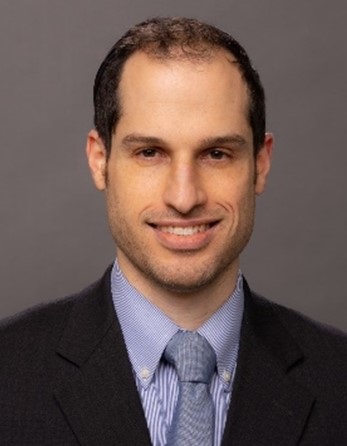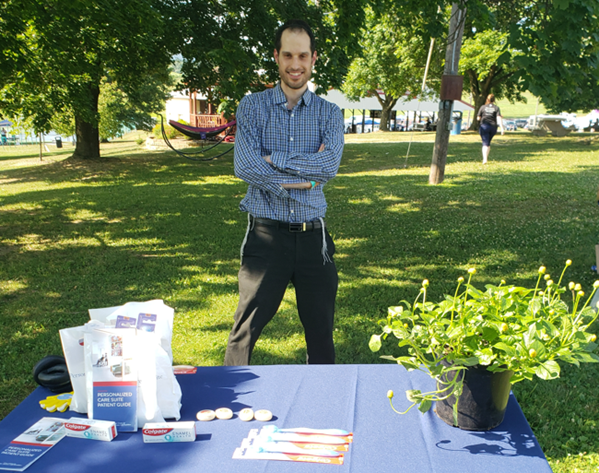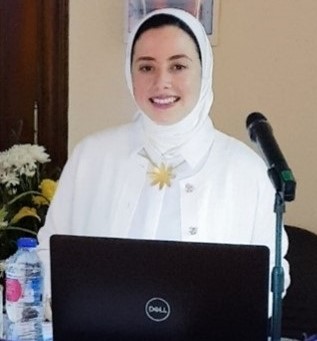AAOM Membership and Members Highlights
 Jeffrey Goetz, DDS, MD, MA Jeffrey Goetz, DDS, MD, MA
My path has been circular, kind of like the oral cavity. I’m currently a second-year resident in oral medicine at Penn Medicine. I entered the field after completing an intern year in primary care-based internal medicine at the University of Nevada, Reno (2020-2021). In 2018-2019 I completed a Master of Arts in Medical Humanities, Compassionate Care, and Bioethics at Stony Brook University. My master’s project focused on steps for unifying my dual-doctoral training in dentistry (2010-2014 New York University College of Dentistry) and medicine (2014-2018, Renaissance School of Medicine at Stony Brook University).
In my duties as an oral medicine resident at Penn Medicine, I enjoy coordinating care at the intersection between dentistry and medicine with my co-residents and attendings. Between the dental school, hospital, and oral medicine clinics, I appreciate the care for our patients’ smiles and oral health as an adjunct to the treatment and prevention of chronic disease. I enjoy connecting this to my interests in the community, public, and global health.
In my personal time, I appreciate nature, art, laughter, and poetry. In my youth, I grew up competitively solving Rubik’s cubes (see Cube Conqueror - Orlando Sentinel to check it out). Today I solve and conquer what stops people from smiling. I look forward to applying these experiences and interests in my continued “circular” development with this profession and toward our mission and vision at AAOM.

That’s me with my dental floss and “tooth-ache plant” representing Penn Dental Medicine at the 2022 Inclusion Festival, a sensory-friendly music and wellness festival, in Kempton, PA. At the event, I provided information about Penn Dental Medicine’s Care Center for persons with disabilities and why oral health is essential for all.
Aliaa Abdelmoniem Bedeir Eita BDS, MD, MRCSEd
Faculty of Dentistry, Oral Medicine, Periodontology, Diagnosis and Radiology Department, Alexandria University, Alexandria, Egypt
The Oral Microbiome and Oral Cancer. Is There a Relation?
Oral squamous cell carcinoma (OSCC) is the commonest head and neck cancer of major global concern to date (1). The clinical challenges of late diagnosis, poor prognosis, and the increased risk of developing second primary tumors provoke the interest in searching for deeper explanations for carcinogenesis which might unleash early diagnostic and prognostic cancer biomarkers (2,3).
According to the Human Oral Microbiome Database (HOMD), the human oral cavity bears 784 different bacterial taxa and 1,567 genomes. (HOMD, www.homd.org) (4). In homeostasis, the oral microbiota is found to play roles in immune response modulation, protection from exogenous pathogens, antimicrobial substances production, modification of food intake and vitamin biosynthesis (5). Dysbiosis occurs when such balance is breached and it is thought to be connected to several diseases. Recently, there is a great interest in the link between dysbiosis and oral carcinogenesis (4,5).
Different microbial species have been detected in OSCC samples as Fusobacterium, Prevotella, Porphyromonas, Rothia, Veillonella and others (4). Besides being detected in significantly elevated amounts in OSCC lesions, P.gingivalis and F.nucleatum are believed to predispose individuals to carcinogenesis (3). Moreover, variations in oral microbiota complexity were noted between potentially malignant lesions and different stages of OSCC (6,7).
It is believed that bacteria could influence tumorigenesis through chronic inflammation and cytokine release, antiapoptosis, promotion of cellular proliferation, and carcinogens production (8). On the other hand, lowered host immune response from malignancy leads to secondary bacterial colonization at the tumor site (9).
The risk factors of OSCC are various and simultaneous. The oral microbiome could be considered an inseparable one. However, more evidence is needed to comprehensively understand the mechanisms of the complex causal relationship between the oral microbiome and cancer development. This would mark the oral microbiome as a reliable diagnostic and prognostic patient screening tool in the future (4). Also, it would enhance the possibility of managing carcinogenic bacteria with precision medicine (10,11).
References
1- Almangush A, Leivo I, Mäkitie AA. Biomarkers for Immunotherapy of Oral Squamous Cell Carcinoma: Current Status and Challenges. Front Oncol. 2021;11:616629. doi: 10.3389/fonc.2021.616629.
2- Sklenicka S, Gardiner S, Dierks EJ, Potter BE, Bell RB. Survival analysis and risk factors for recurrence in oral squamous cell carcinoma: does surgical salvage affect outcome? J Oral Maxillofac Surg. 2010;68(6):1270-5. doi: 10.1016/j.joms.2009.11.016.
3- Perera M, Al-Hebshi NN, Speicher DJ, Perera I, Johnson NW. Emerging role of bacteria in oral carcinogenesis: a review with special reference to perio-pathogenic bacteria. J Oral Microbiol. 2016;8:32762. doi: 10.3402/jom.v8.32762.
4- Tuominen H, Rautava J. Oral Microbiota and Cancer Development. Pathobiology. 2021;88(2):116-126. doi: 10.1159/000510979.
5- Wang B, Yao M, Lv L, Ling Z, Li L. The human microbiota in health and disease. Engineering. 2017;3(1):71–82.
6- Lee WH, Chen HM, Yang SF, Liang C, Peng CY, Lin FM, et al. Bacterial alterations in salivary microbiota and their association in oral cancer. Sci Rep. 2017;7(1):1654Fe
7- Yang CY, Yeh YM, Yu HY, Chin CY, Hsu CW, Liu H, et al. Oral Microbiota community dynamics associated with oral squamous cell carcinoma staging. Front Microbiol. 2018; 9:862.
8- Zhang Y, Wang X, Li H, Ni C, Du Z, Yan F. Human oral microbiota and its modulation for oral health. Biomed Pharmacother. 2018; 99:883–93.
9- Cummins J, Tangney M. Bacteria and tumours: causative agents or opportunistic inhabitants? Infect Agent Cancer. 2013;8(1):11.
10- Xu H, Cao B, Li Y, Mao C. Phage nanofibers in nanomedicine: biopanning for early diagnosis, targeted therapy, and proteomics analysis. Wiley Interdiscip Rev Nanomed Nanobiotechnol. 2020;12(4):e1623.
11- Cisek AA, Dąbrowska I, Gregorczyk KP, Wyżewski Z. Phage therapy in bacterial infections treatment: One hundred years after the discovery of bacteriophages. Curr Microbiol. 2017;74(2):277–83.
|